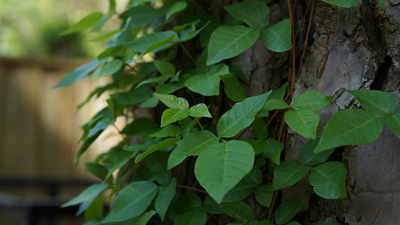Poison Ivy

Poison Ivy doesn’t pose a threat in our gardens to out competing the perennials or vegetables, rather it is mainly an issue because of the reactions it causes. Poison Ivy has three leaflets that can be toothed or lobed and can often be found as a vine growing up trees or as a groundcover if it cannot grow upwards. In the fall poison ivy turns bright red in a beautiful and colorful display. This native vine is often confused with Virginia Creeper which is also a vine and ground cover that has leaflets in groups of five.
The issue with poison ivy is the resinous compounds called urushiols that are present in all parts of the plant. The unfortunate part is you don’t have to touch poison ivy to have a reaction, the compound can get on tools, clothes, pets or even in the air if the plant is brushed and you can have a reaction from those. Even the dead parts of the plant contain the chemical and it can become airborne if the plant is burned.
To control poison ivy, first dress the part. Cover as much skin as possible with long sleeves, long pants, closed toed shoes and gloves. Small plants can be pulled with care but herbicides with triclopyr or glyphosphate can be applied when the plant is actively growing for control. You will likely need to make multiple applications in order to achieve full control. If you believe you came in contact with the plant, change clothes and wash immediately. Rubbing Alcohol can help remove the oils and prevent the rash from spreading.

